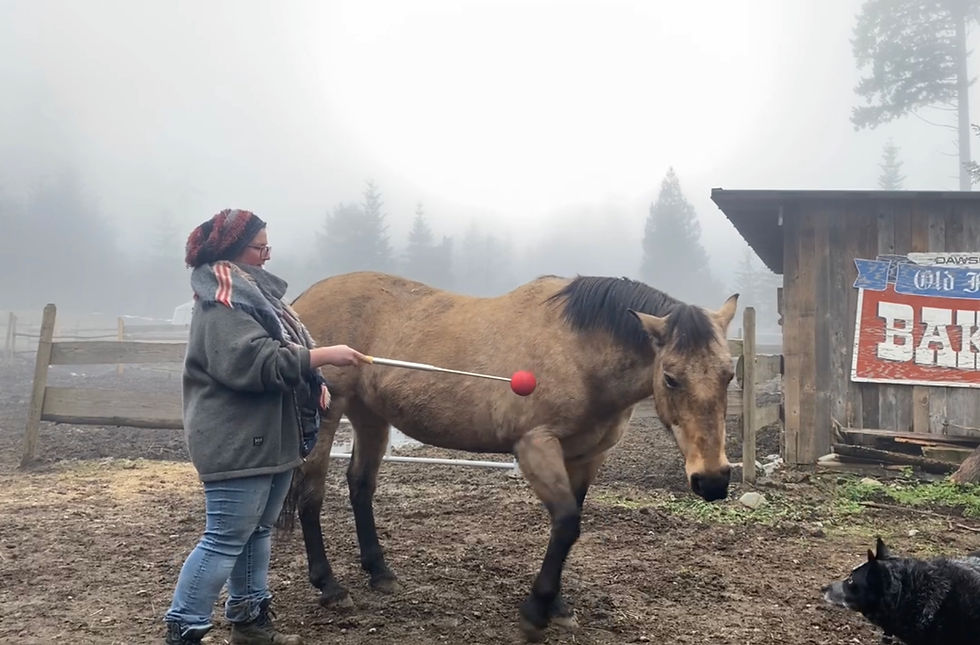5 Common Misconceptions/Myths about Positive Reinforcement (R+)
- Leslie Rohr
- Feb 20, 2022
- 3 min read
Updated: Feb 24, 2022
Positive Reinforcement is often very misunderstood. Especially the horse world is plagued with old school beliefs and misconceptions around the use of food with horses. Many of these myths are shared without full understanding of how positive reinforcement and operant conditioning functions and so today I wanted to share the most common myths around R+ training and why they are false.

Myth 1: Food makes horses pushy/ dangerous/aggressive.
Horses become pushy because they either -are not taught how to behave around food, or -they were accidentally taught the wrong thing. In R+ training, food manners and safety are important skills that are prioritized by trainers. This is very easily done, and ensures the training stays fun for everyone. Zoos train many “dangerous” and wild animals with R+. If we can train tigers, elephants and gorillas, safely with R+, we can train our horses with it😉
Myth 2: Positive reinforcement is just bribery.
Positive reinforcement isn’t bribery. A bribe brings food out before a behaviour happens. In positive reinforcement, food is brought out as a reward AFTER a behaviour happend. Which is how it is utilitzed in R+ training majority of the time.
Now you may see the use of food lures on an occasional basis, which could be considered bribery from a human perspective. But we must remember that horses simply do not have the same negative association with it as humans would. So even if a food lure is utilized it doesn't harm your training in any way.
Myth 3: Positive reinforcement doesn't work for horses.
R+ works for all Animals. even Humans! All animals learn through operant conditioning on a daily basis. We as humans just choose to utilize certain quadrants in order to cause a behaviour change in other animals. Traditional training utilizes mainly negative reinforcement(pressure release) and positive punishment. R+ trainers simply choose to prioritize the Positive Reinforcement Quadrant over the other 3, and many follow the humane hierarchy as a guide.
Myth 4: The horse will only work food, and not for their relationship with you.
The same could be said for traditional training. The horse only works to avoid aversives-or pressure.
A good Relationship doesn’t come just from training, it comes with your daily interactions with your animals. You can have good training and no relationship. Or you can get a good relationship, with no direct training. Both is best!
R+ does builds positive associations for the horse with their handler and their work more easily. And horses will happily do a behaviour with a strong reinforcement history without the use of a reward for a few repetitions in case this would he necessary.
Now, although the reinforcers cannot ever be fully removed (the reinforcers being pressure in R- training and rewards such as food in R+ training)
They can be minimized and in R+ training we can raise criteria. So for example, first we reward for any canter transition, but more and more strides can be added to the task, and soon the horse will happily canter multiple rounds before receiving their reward.
Myth 5: R+ training means you let your horse get away with things.
Often people feel that, because we don’t punish our horses or give them consequences for “incorrect” behaviour, it means that the horses are just allowed to behave however they want. But this is untrue. in R+ training, the focus lies less on what behaviours we do not want, but more so on which behaviours we DO want.
The rule is generally to avoid unwanted behaviour by setting the horse up for success at all times. This means ensuring the horse stays under threshold during learning.
But let's say a horse expresses an unwanted behaviour during training, such as kicking out their feet while lifting it up. Instead of punishing them by “making them work” for example, we instead reward the horse for holding their leg still. This works because the horse finds the benefit of receiving a reward stronger than the benefit of kicking out to avoid the aversive. in comparison, the positive reinforcement of the correct behaviour builds a more positive association for the horse about having their feet worked on than "correcting" the wrong one.
Positive reinforcement isn’t just shovelling “cookies” into the horses mouth. It is the deliberate and calculated application of rewards. It does require a bit of a change in mindset, and a whole new set of skills. But with a bit of creativity, anything that can be taught with R-, can also be taught with R+


Comentarios